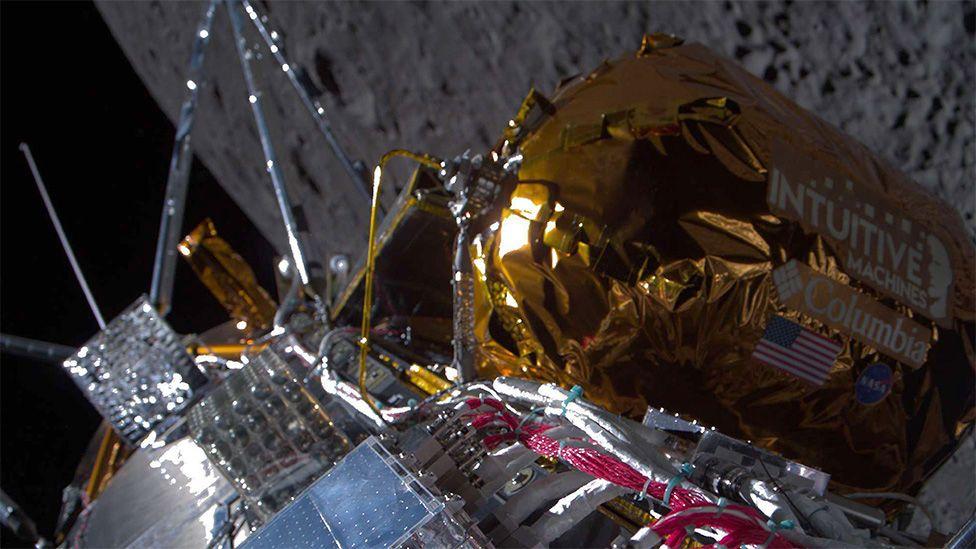First commercial Moon mission marks new era for space travel
The landing of a first commercial spacecraft on the Moon has sparked excitement about a new age of possibilities in the Solar System.
News of the touchdown of Odysseus near the lunar south pole was greeted with cheers by staff at American firm Intuitive Machines’ (IM) mission control in Houston, Texas, on Thursday.
It is the first time an American craft has successfully landed on the Moon since 1972 – and the first time ever that a private company has done so.
But the giant leap for commercial kind could also help future state missions to the lunar surface and perhaps even aid plans to set up a lunar – or Martian – base for humans.
Neil deGrasse Tyson, one of America’s most famous astrophysicists, believes missions of this kind “should have been happening decades ago.”
But he told the BBC’s Americast that further state-funded missions might be needed before many private businesses look seriously at opportunities in space, given the level of up-front funding needed to get ventures off the ground.
“There is no business case to go into space first,” Mr deGrasse Tyson argued.
He suggested that if the US put a base on Mars then “after that’s done, the expensive way, private enterprise can say ‘well, maybe there is another way to get there that is cheaper’.”
“Maybe you set up an amusement park or a tourist visiting site if it’s cheap enough.
“But if you can’t get the price down then it’s not going to happen.”
There are hopes that the touchdown could plant the seeds of a wider, thriving lunar economy. The vision involves a range of companies buying and selling services such as transport, communication and power.
Nasa is trying to encourage firms to get involved in exploration beyond Earth, with the US space agency engaging a number of companies to take its scientific instruments to the Moon. These private entities build, launch and operate their missions.
Watch: There were celebrations at the Texas company Intuitive Machines
Nasa purchased room on Odysseus for six scientific instruments, and some of its equipment helped the robot craft overcome technical issues – demonstrating the capacity for private and state actors to co-operate successfully in the space exploration industry.
The mission is part of Nasa’s Commercial Lunar Payload Services (CLPS) programme, in which the agency is paying various private American companies for transport services to the Moon – in this particular case, with a fee of $118M (£93m).
IM’s effort follows that of another private entity, Pittsburgh-based Astrobotic, which set off for the Moon in early January but could not even attempt a landing because of technical problems.
IM, which claims to “open access to the Moon for the progress of humanity”, was founded by Kam Ghaffarian, Stephen Altemus and Tim Crain – all of whom have significantly lower profiles than the likes of Elon Musk and Richard Branson.
That billionaire duo have both tried their hands at different forms of private space exploration – with varying degrees of success – and are planning further forays.
Many firms will see the risks and costs involved as reason enough to remain Earth-bound.
But other companies are also hoping to get involved in trips to the Moon, which had seen relatively little interest compared with the much-hyped – and state-based – “Space Race” of the mid to late 20th Century.
Only a handful of other countries have since successfully landed a spacecraft on the Moon’s surface – the state space programmes of the then Soviet Union, China, India and Japan.
 IMAGE SOURCE,INTUITIVE MACHINES
IMAGE SOURCE,INTUITIVE MACHINESYet in Europe, too, interest now appears to be picking up. Some of Odysseus’ communications are being facilitated by Goonhilly Ltd in Cornwall, UK, which has several large radio dishes capable of picking up signals from the Moon’s surface.
Nearby Surrey Satellite Technology Ltd, of Guildford, is building a telecoms spacecraft that will circle the Moon to provide a relay service to anyone who needs to get data back to the Earth.
Meanwhile, Nasa has a shortlist of lunar locations to send astronauts to later this decade in its Artemis programme – and one of them is Odysseus’ targeted landing site, known as Malapert.
It is the southernmost point on the Moon ever visited by a spacecraft, and scientists think there could be frozen water nearby which could be vital to future missions.
But the key question is how sustainable a lunar economy can become long-term.
Will there be enough activity at the Moon to justify investors’ courage in building the emerging infrastructure?
For the foreseeable future, government funding will have to prop up this industry.
That all means it may be quite some time before a thriving lunar economy is able to establish itself.
The post First commercial Moon mission marks new era for space travel appeared first on .

